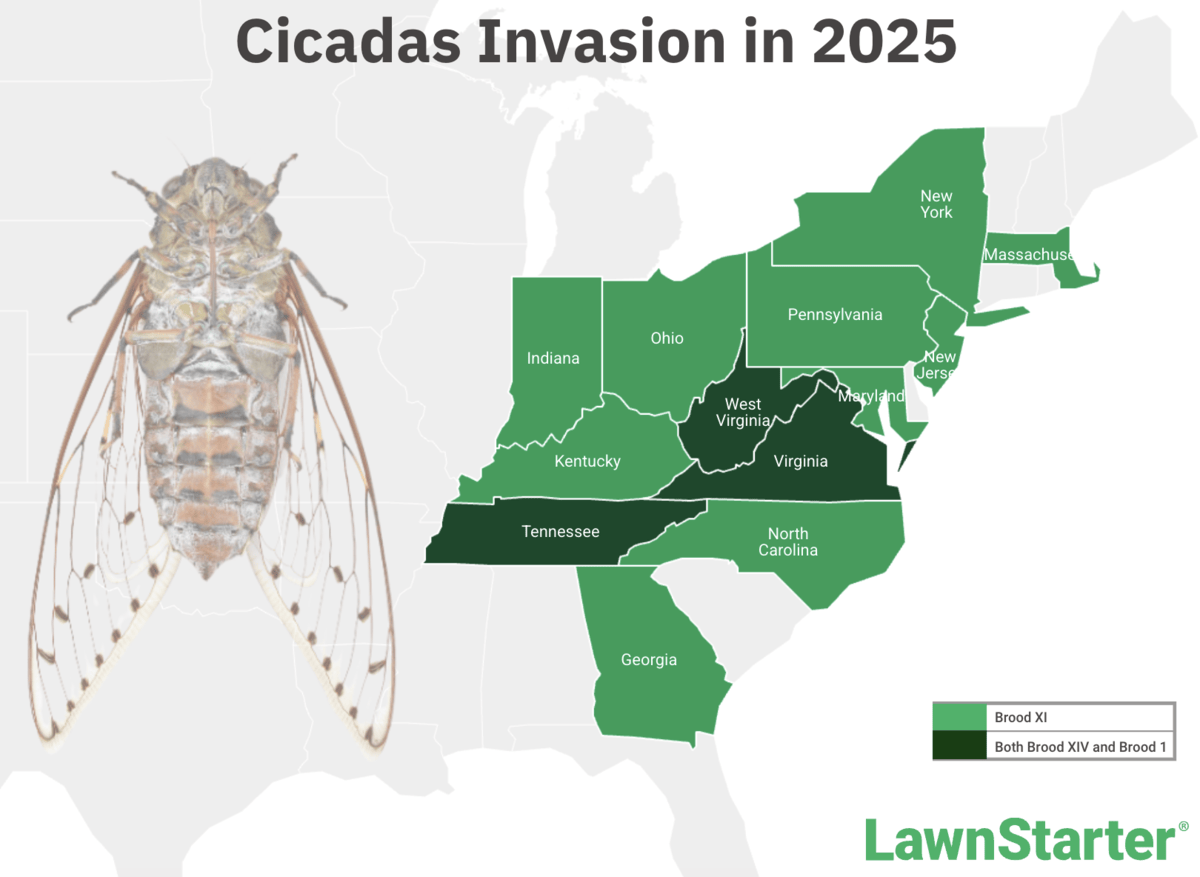
We survived the Cicadapocalypse last year, so what’s the forecast for 2025? There will be trillions of these little buzzing buggers swarming over 13 states stretching from Georgia up to New York.
How bad will it be? In some areas, there will be millions per acre. Perhaps 1.5 million per acre.
The good news? Cicadas won’t eat your grass or destroy your lawn, and these noisy pests can even benefit your lawn as a natural form of aeration as they rise from the ground.
How to get rid of cicadas? You can remove them, or let them be, or even eat them. (They are a great source of protein.) The EPA doesn’t recommend pesticides to get rid of cicadas — there are too many and the pesticides can also cill beneficial insects.
Get ready. Cicadas emerge after leaves appear on the trees. Think late spring.
In 2025, two broods of cicadas are expected to emerge:
- Brood XIV is one of those that emerge every 17 years. It might be as large as Brood XIII, the 17-year cicadas that emerged in 2024.
- Brood I is another 17-year cicada, due to emerge in 2029, but likely at least partly emerging early this year. See, with cicadas, strands of a brood sometimes emerge four years early.
But there isn’t good data on how many Brood 1 cicadas will emerge early. The last time they emerged early was in 2012. But as soon as they emerged in spring, the weather turned wintry and a lot of the early-arrival cicadas died in the wet and cold.
Fun Fact: The term for cicadas that emerge off-cycle is “stragglers,” even though they aren’t arriving late but are arriving early.
Invasion 2025 vs. 2024 by the numbers
The 2024 invasion of cicadas in 2024 was forecast to reach billions. Ha! It was a lot more:
- Trillions, which is 1,000 billion, emerged in 2024, according to the U.S. Department of Agriculture and the Forest Service, for example. The forecast for the year was “billions.” But they just kept coming.
- Quadrillions, which is 1,000 trillion, is the number of cicadas that invaded the U.S. in 2024, according to John R. Cooley, professor-in-residence of Ecology and Evolutionary Biology at the University of Connecticut. He should know: For most of 2024, he traveled the U.S. to study the cicadas invasion.
The 2025 invasion isn’t expected to be as large as the one in 2024. Expect:
- Trillions, according to Farmers’ Almanac and to the University of Connecticut, considered an authoritative voice, in part because that’s where Cooley is based.
Looking ahead: Longer-Range Cicada Forecast
This is the schedule of the emergence of cicadas and their primary locations, through 2041.
This does not include broods that emerge early.
| Year | Brood | Location |
| 2027 | Brood XII | Louisiana, Mississippi |
| 2028 | Brood XXIII | Arkansas, Illinois, Indiana, Kentucky, Louisiana, Missouri, Mississippi, Tennessee |
| 2029 | Brood I | Virginia, West Virginia |
| 2030 | Brood II | Connecticut, Maryland, North Carolina, New Jersey, New York, Pennsylvania, Delaware, Virginia, District of Columbia |
| 2031 | Brood III | Iowa |
| 2032 | Brood IV | Iowa, Kansas, Missouri, Nebraska, Oklahoma, Texas |
| 2033 | Brood V | Maryland, New York, Ohio, Pennsylvania, Virginia, West Virginia, |
| 2034 | Brood VI | Georgia, North Carolina, South Carolina |
| 2035 | Brood VII | New York |
| 2036 | Brood VIII | Ohio, Pennsylvania, West Virginia |
| 2037 | Brood IX | North Carolina, Virginia, West Virginia |
| 2037 | Brood XIX | Alabama, Arkansas, Georgia, Indiana, Illinois, Kentucky, Louisiana, Maryland, Missouri, Mississippi, North Carolina, Oklahoma, South Carolina, Tennessee, and Virginia |
| 2038 | Brood X | Delaware, District of Columbia, Georgia, Illinois, , Indiana, Kentucky, Maryland, Michigan, New York, New Jersey, North Carolina, Ohio, Pennsylvania, Tennessee, Virginia, West Virginia |
| 2041 | Brood XIII | Illinois, Indiana, Iowa, Wisconsin |
Yes, this means that there is no invasion expected in 2026. However, the number of cicadas arriving four years early keeps increasing. And since the early-arrivals are found in areas that did not get their usual arrivals (perhaps trying to take over the space), 2026 could turn into a boom year for an early arrival of Brood II.
How to Limit Damage from Cicadas
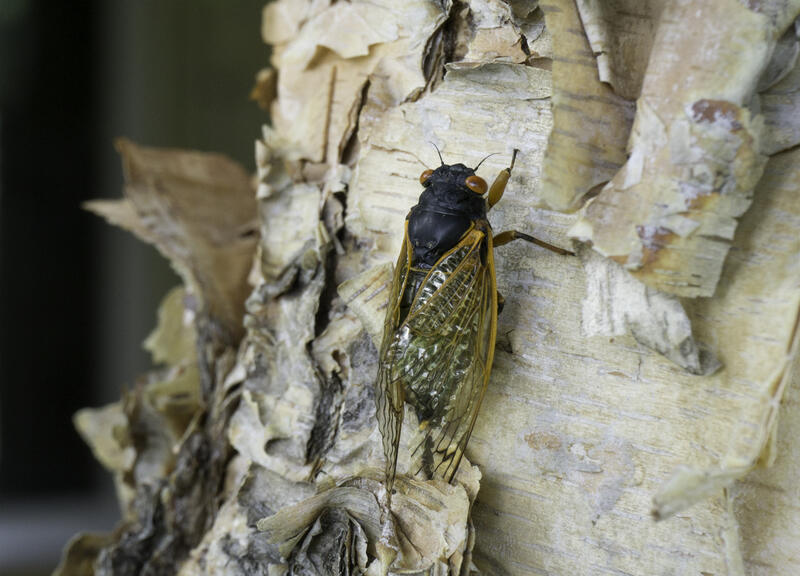
You can’t prevent cicadas from coming, but you can limit the damage to your yard and your hearing.
- Invest in earplugs or noise-canceling headphones. Cicadas are not quiet insects and will even put airplanes to shame.
- Cover pools and hot tubs. Cicadas tend to fly into them and can clog the drain.
- Do yard work in the early morning or at dusk, when cicadas are less active. Why? The vibrations from your lawn equipment can attract cicadas. Cicadas come up for mating season and the males make their sounds through vibrations. You may be making a date without knowing it.
- Wear a hat when working under trees or in your yard. Cicadas like to pee after filling up on tree sap.
How to Protect Your Trees
The billions of cicadas that emerge will quickly make their way to trees. To protect your trees:
- Spray often with a strong hose.
- Wrap smaller and younger trees with netting that has openings of less than ¼ inch.
Cicadas won’t eat the leaves of trees, but they will damage trees:
- Female cicadas cut slits into the bark to lay their eggs.
- The eggs hatch.
- The nymphs drop to the ground.
- The nymphs bury themselves until they find a tree root.
- The cicada nymphs attach themselves to the root.
- The nymphs suck out the sap and juices.
Trees at risk
| Apple | Hickory |
| Ash | Maple |
| Cherry | Oak |
| Chestnut | Peach |
| Dogwood | Pear |
| Elm |
Pro Tip: Fruit trees, nursery trees, and trees recently transplanted are at the greatest risk.
How to Get Rid of Cicadas (or Tolerate or Eat Them)
How to get rid of cicadas? That’s not easy.
Don’t try to get rid of cicadas by using insecticides, the EPA says. You’re wasting your time and money. Here’s why:
- So many cicadas emerge at a time that as soon as one group dies another emerges.
- Insecticides might blow back into your face.
- Insecticides might blow off into the face of your child, other family members, or neighbors.
- Pets are always at risk when you use insecticides.
Finally, a National Institutes of Health study found that the use of insecticides on cicadas had no benefit.
If You Must Use Insecticides in Your Cicada Fight
Bifenthrin can be used to get rid of cicadas. It is a manmade version of an element found in chrysanthemums. It is toxic to insects and pets due to their small size; humans are large enough to not be injured, according to the National Pesticide Information Center.
- In humans, bifenthrin can cause skin to have tingling, itching, burning, or numbness for as long as 48 hours. Inhaled, it might irritate the nose, throat, and lungs. If eaten (perhaps accidentally), it immediately causes sore throat, vomiting, and abdominal pain.
- In pets, there will be vomiting, diarrhea, drooling, and perhaps twitching. Extreme cases result in head bobbing, some paralysis, and tremors. By the way, chrysanthemums are among 28 plants that are poisonous to dogs.
So what can you do to get rid of cicadas? Maybe you don’t need to get rid of them. Maybe you can tolerate the buzz and invasion for a month. Cicadas don’t live long. Maybe four weeks.
Why You Might Want to Tolerate Cicadas
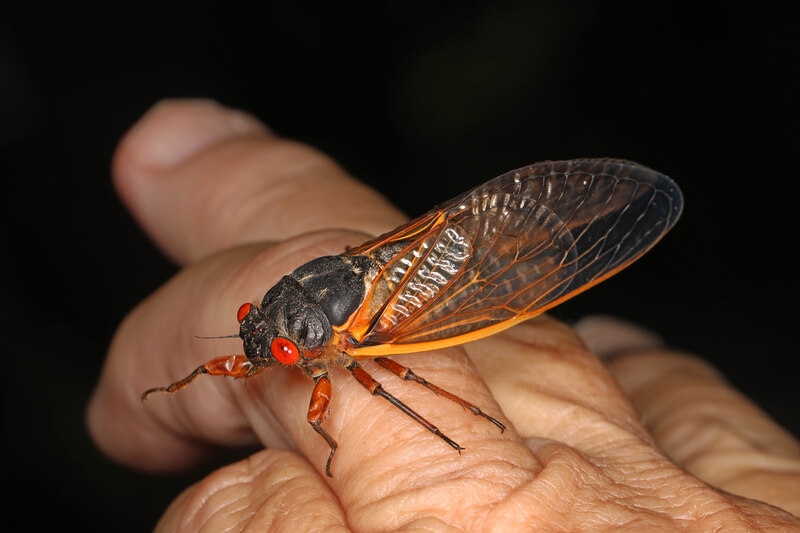
Some reasons you might not want to get rid of cicadas:
- Cicadas are harmless. Why waste your time and money on something that does so little damage?
- Cicadas are important. They provide lots of food for birds, fish and wildlife.
- Cicadas are good for your lawn, LawnStarter says.
See also the FAQ about What Are Good Things Cicadas Do?
How to Eat Cicadas
If you’re adventurous, try eating cicadas. Why? There are a number of reasons:
- Cicadas are a good source of protein. Cicadas have a lot of protein. 50% more protein than, say, fish.
- Cicadas will be easy to find. All that noise-making leads you right to them.
- Cicadas are easy to gather. There are tens of thousands grouped together, which makes them easy to pick up. You can freeze cicadas for use later.
- Cicadas are easy to eat. When they emerge from their shells, cicadas are soft, making them easy to eat. If you come across cicadas emerging from the ground, wait an hour or so, they will have left their shells by then.
What Do Cicadas Taste Like?
Cicadas have a nutty taste and remind people of shrimp, according to the Food Network. In fact, cicadas are related to shrimp and lobster, so if you have shellfish allergies, you should avoid eating cicadas.
How to Eat Cicadas
- Cook them. It makes sure that any tiny organisms are killed off.
- Chop them. Put the cicada bits into sauces. Say, in your spaghetti sauce.
- Sprinkle them. As you would a spice on, say, vegetables.
- Bake them. For 10 minutes or so. Eat cicadas as a snack. Stick a toothpick in cicadas and call them an hors d’oeuvre.
- Make a spice. Bake them. Grind them. Sprinkle them to taste, using cicadas like thyme or basil.
- Sauté them. Then eat the cicadas as you would sautéd mushrooms.
- Deep fry cicadas. Less than a minute.
Hire a Pest Control Pro to Get Rid of Cicadas
It will take a lot of your time and money to constantly battle the tens if thousands of cicadas that can emerge on your property. You might want to bring in a local pest control pro.
The cicada forecast has pest control pros on watch and ready in regions expected to experience this year’s plagues of locusts (another word for cicadas).
Everything To Know About Cicadas
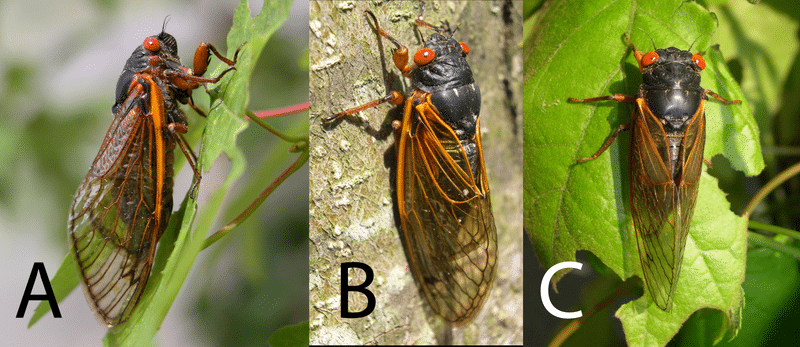
Photo Credit: Fontaine K, Cooley J, Simon C (2007) / Wikimedia Commons / CC BY 2.5
What is a Cicada?
Adult cicadas vary in size depending on the species but are usually:
- Length: 2-3 inches
- Wings: Large, clear, and veiny
- Eyes: Can be reddish or black.
- Movement: Crawling, flying, but not jumping
There are two basic groups:
- Annual: Ones come once a year, like Santa Claus. Usually in early summer.
- Periodical: Ones that appear once every 13 or 17 years. Usually in late spring.
Why cicadas rise up from the ground:
- Mate. After which the male dies.
- Breed. The female produces 500 eggs, then she dies.
Common Names for Cicadas
- Locusts: In the pioneer days, settlers would say they were overwhelmed by “locusts” instead of properly identifying the times it was cicadas.
- Grasshoppers: Colonists from Sweden not only brought the style of notched-corner log cabin that became common in America but also their name for these insects overwhelming their fields: Grasshoppers.
- Dog-Day Cicadas. These are annual cicadas, named for appearing in the dog days of summer, which is later than most cicadas.
- Harvestfly. Dates back to the 1700s, when settlers would do the hard work and weeding and fertilizing the fields they depended on to harvest.
- Heatbug. For ones that appear in the heat of the summer.
- Jarflies. Term first used in the Appalachia region. When you held them in your hand, the motion of their wings would jar you.
What Cicadas Do Not Bite or Eat
- People. Even if cicadas did bite, they are not poisonous or venomous, according to the EPA’s cicada fact sheet.
- Pets. If your dog or cat eats a few, it is a good source of protein. But should a dog or cat eat too many, they might vomit up the cicadas.
- Leaves
- Flowers
- Fruits
- Garden produce
Cicada Noise: Musical, Deafening … Relaxing?
When the cicada emerges, the males try to attract a mate by making a sound that is described as:
- Loud. They are the loudest insects in the world, especially when there are thousands in a tree. But they aren’t so loud that you have to shout to be heard.
- Awful. If you walk through a forest of trees packed with cicadas, the noise level reaches that of a rock and roll concert in a packed arena.
- Deafening. The CDC looked into cicada noise and reported that human ears won’t be damaged unless cicada noise is at its peak for at least 15 minutes. So if you are in a situation in which the cicada noise reaches the level of a jet engine, you should … walk away. Being even 6 feet away is enough to avoid hearing loss.
- Musical. There are discussion groups that will try to describe “the song of the cicadas.”
- Shrill according to the University of California.
- Buzzing. Even the NIH uses the term to describe the sound made by cicadas.
- Peaceful, soothing, relaxing. If you like the sound of nature as you are, say, lying in your bed at night, or sitting on your front porch.
How Do Cicadas Make That Noise?
- Male cicadas make a distinctive sound by flexing membranes found at the top of their abdomens called “tymbals.” They have a muscle inside that pulls and pushes the tymbal, making a sound. They can do this 480 times per second. Their abdomens are empty, so the sound resonates.
- Females respond to the mating call of the male by flicking their wings. Females do not have a tymbal.
- Together the males and females call and respond. This is the sound that people associate with the cicadas, trees full of males and females that are finding each other. All of that noise leads to a single male and a single female … finding each other among the millions in the tree.
FAQ About Cicadas
What Are Good Things Cicadas Do?
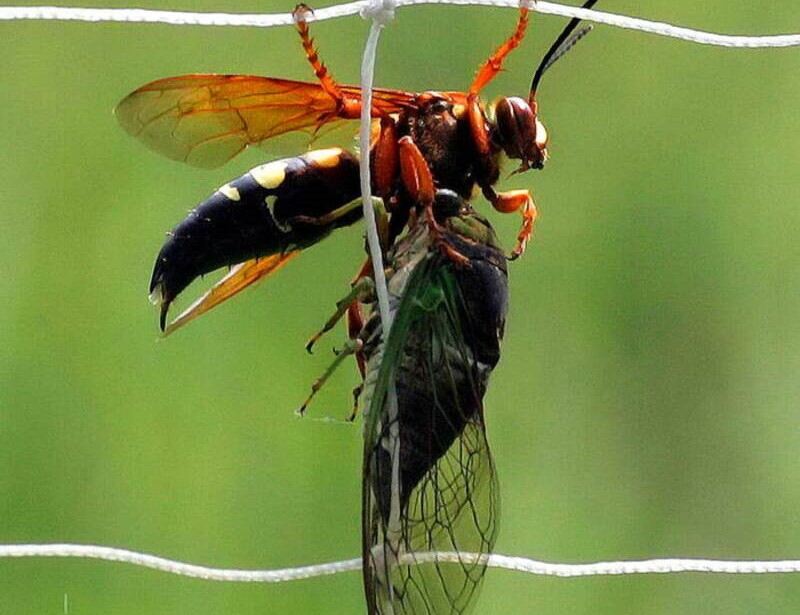
Photo Credit: Pixnio
- A great food source for birds, wasps, and bats.
- Aerate the ground. You don’t have to go to the trouble yourself.
- Improve the soil as they decompose.
What to Do with Cicada Bodies?
There can be millions of rotting, stinking cicadas on your property. You can:
- Add them to your compost bin.
- Bury them
- Burn them
How Widespread Are Cicadas?
Cicadas are found on every continent but Antarctica. There are 190 species and subspecies of cicadas in North America. There are 3,390 varieties around the world.
Are Cicadas a Danger to Vines?
When it comes to protecting grapevines and other climbing plants, you may need to pluck off cicadas one-by-one. (This is a great chore for the kids!)
Let’s End with Some Cicada Reminders
Cicadas won’t harm you or your lawn, but they may bedevil you and your family for a few weeks. And if your pets eat a few cicadas, that’s OK. Cicadas may cause stomach upset or vomiting, but eating a few cicadas is unlikely to kill your dog or cat.
How to deal with the billions of cicadas expected this year? Be strong and try to put up with them or eat them (no I wouldn’t try this either).
Don’t try to get rid of cicadas by using insecticides. The EPA and NIH both say insecticides won’t work and have no effect.
Look to LawnStarter for an annual Cicada Forecast. Some of you will be cursed (or blessed – if you find their sound relaxing) with cicadas, depending on the year and where you live. We might even have some new cicada recipes to try.
Main Image Credit: anatchant / Canva Pro / License created using Infogram